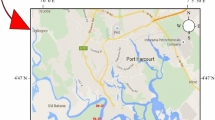Abstract
Water is essential for living things, and thus international regulations or standards are set to reduce and prevent pollution. The purpose of this study was to evaluate water quality and to compare the concentration by variables over a two-year period. Sampling was conducted for one month at five sites along the Wangsukcheon river in Gyeonggi-do, Korea. General measurements (dissolved oxygen, DO), pH, temperature, electrical conductivity (EC) were taken using a YSI 556. The biochemical oxygen demand (BOD), chemical oxygen demand (COD), and suspended solids (SSs) were analyzed manually according to the standard method. The concentration of most elements was lower in 2013 than in 2012. Most of the time, the patterns of concentration for the five sites increased from summer to winter. In addition, the levels of COD, BOD, total nitrogen (TN), total phosphorus (TP), and EC at site E were higher than at the other sites. In the correlation analysis results, TN and EC were positively correlated, but DO and temperature (TEM) were negatively correlated. Therefore, this study suggests that some management is required to clean the water and improve the quality at downriver locations in the winter season.
Similar content being viewed by others
References
Guidelines for Canadian recreational water quality, http://www.hc-sc.gc.ca/ewh-semt/alt_formats/pdf/pubs/water-eau/guide_water-2012-guide_eau/guide_water-2012-guide_eau-eng.pdf (2012).
Water quality standards, http://www.epa.gov/region9/water/waterquality/ (2011).
Guidance for reporting under the water framework directive, https://circabc.europa.eu/sd/a/253e424b-591b-4ad9-b9b1-4dd64ff4f45c/Guidance%20document%2021_Guidance%20for%20reporting%20under%20the%20WFD.pdf (2000).
Minister of Environment. Water quality standards. (2012).
Austin, B. et al. The effects of pollution on fish health. J. Appl. Microbiol. Symp. Suppl. 85, 234–242 (1999).
Boyer, R. et al. The need for water quality criteria for frogs. Environ. Health Perspect. 103, 352–357 (1995).
Snawder, J. E. et al. Toxic and developmental effects of organophosphorus insecticides in embryos of the South African clawed frog. J. Environ. Sci. Health. 24, 205–218 (1989).
Cooman, K. et al. Tannery wastewater characterization and toxicity effects on Daphnia spp. Environ. Toxicol. 18, 45–51 (2003).
Prüss, A. et al. Review of epidemiological studies on health effects from exposure to recreational water. Int. J. Epidemiology 27, 1–9 (1998).
Fleisher, J. M. et al. Health effects and exposures from non-point source microbial contaminants in subtropical recreational marine waters. Int. J. Epidemiology 39, 1291–1298 (2010).
Haile, R. W. et al. The health effects of swimming in ocean water contaminated by storm drain runoff. Epidemiology 10, 355–363 (1999).
Berg, R. W. et al. Association of skin wetness and pH with diaper dermatitis. Pedia. Dermatol. 11, 18–20 (1994).
Minister of Environment. The plan of improvement of water quality. The Press report (2006).
Minister of Environment. The performance evaluation of plan of improvement. The Press report (2003).
Vaishali, P. et al. Assessment of seasonal variation in water quality of River Mini, at Sindhrot, Vadodara. Int. J. Environ. Sci. Health. 3, 1424–1436 (2013).
Verma, A. K. et al. Seasonal variations in surface water quality of Sengar river due to effluent from petrochemical industry. J. Env. Dev. 5, 912–919 (2011).
Rahman, A. K. et al. Study of the seasonal variations in Turag river water quality parameters. Afr. J. Pure Appl. Chem. 6, 144–148 (2012).
Poudel, D. D. et al. Assessment of seasonal and spatial variation of surface water quality, identification of factors associated with water quality variability, and the modeling of critical nonpoint source pollution areas in an agricultural watershed. J. Soil Water Conserv. 68, 155–171 (2013).
Kim, J. M. et al. Water quality fluctuation study of Paldang reservoir affected by Gyeongan stream inflow according to rainfall. Korean J. Limnol. 39, 236–244 (2006).
Ahn, H. K. et al. Impact of livestock waste on the water quality of Paldang reservoir. J. Anim. Sci & Technol. Kor. 43, 569–586 (2001).
Walakira, P. et al. Impact of industrial effluents on water quality of streams in Nakawa-Ntinda, Uganda. J. Appl. Sci. Environ. Manage. 15, 289–296 (2011).
Son, J. G. et al. Correlativity analysis between water quality items in the dowoncheon basin for agricultural watershed management. J. Soc. Agr. Eng. Kor. 48, 77–86 (2006).
Park, H. J. et al. A study on the influence of water quality on the upper stream of Hap-Chun lake. J. Kor. Soc. Environ. Eng. 35, 94–100 (2013).
Khatoon, N. et al. Correlation study for the assessment of water quality and its parameters of Ganga River, Kanpur, Uttar Pradesh, India. J. Appl. Chem. 5, 80–90 (2013).
Moore, K. A. et al. Eelgrass survival in two contrasting systems: role of turbidity and summer water temperatures. Mar. Ecol. Prog. Ser. 448, 247–258 (2012).
Seilheimer, T. S. et al. Impact of urbanization on the water quality, fish habitat, and fish community of a Lake Ontario marsh, Frenchman’s Bay. Urban. Ecosyst. 10, 299–319 (2007).
Author information
Authors and Affiliations
Corresponding author
Additional information
These authors contributed equally to this work.
Rights and permissions
About this article
Cite this article
Lee, LK., Kim, JH. & Kim, J. Monitoring the water quality of the Wangsukcheon river over a two-year period. Toxicol. Environ. Health Sci. 7, 91–96 (2015). https://doi.org/10.1007/s13530-015-0225-1
Received:
Revised:
Accepted:
Published:
Issue Date:
DOI: https://doi.org/10.1007/s13530-015-0225-1




